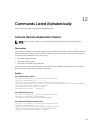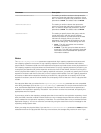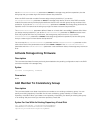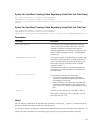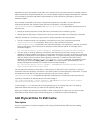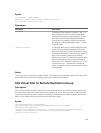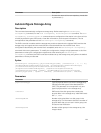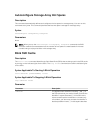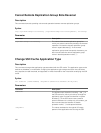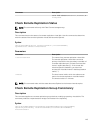
operations on each of the base virtual disks. In the context of this command, the term member means a
base virtual disk for snapshot operations. You can manipulate snapshot images associated with members
of a consistency group through batch-style operations, while maintaining consistency across the
snapshot images.
Each member virtual disk must have a corresponding repository virtual disk. You can define the
relationship between the member virtual disk and the repository virtual disk using the
repositoryVirtualDisk parameter. The repositoryVirtualDisk parameter can perform one of
these actions:
• Identify an existing repository virtual disk that is connected to the consistency group.
• Identify either a disk group or a disk pool in which you want to create a new repository virtual disk.
Adding a member to a consistency group with an existing repository has two purposes:
• You can create an entirely new repository virtual disk by running the command without the
repositoryVirtualDisk parameter. When you run the command without the
repositoryVirtualDisk parameter, the command creates a new repository virtual disk in the disk
group or disk pool in which all the other repository virtual disks are stored. An example of this
command usage is:
set consistencyGroup ["First_Images"] addCGMemberVirtualDisk="Data_020212"
• You can reuse an existing repository virtual disk if that repository virtual disk is empty and is not
related to another member virtual disk. You might want to do this if you want to maintain a particular
sequence or relationship for the repository virtual disks. To reuse an existing, empty repository virtual
disk you need to know the name of the repository virtual disk. To determine the name of the
repository virtual disk, use the show allVirtualDisks summary command. All repository virtual
disk names have the form repos_XXXX where XXXX is a unique identifier generated by the MD
storage management software. An example of this command usage is:
set consistencyGroup ["First_Images"] addCGMemberVirtualDisk="Data_020212"
repositoryVirtualDisk="repos_0011"
You can place the repository virtual disk in a disk group or a disk pool of your choosing. You are not
required to have the repository virtual disk in the same location as other repository virtual disks. To place
the repository virtual disk in a disk group or a disk pool of your choice, use the
repositoryVirtualDisk parameter and identify the disk group or the disk pool and a size for the
repository virtual disk. An example of this command usage is:
set consistencyGroup ["First_Images"] addCGMemberVirtualDisk="Data_020212"
repositoryVirtualDisk=("12" capcity=2 GB)
In this example, "12" is the name of an existing disk group or an existing disk pool. The capacity
parameter defines the size that you want for the repository disk group.
When you create a new repository virtual disk in either a disk group or a disk pool, you must include
parenthesis around the disk group name and capacity, or the disk pool name and capacity.
Add Physical Disks To SSD Cache
Description
Use this command to increase the capacity of an existing Solid State Disk (SSD) cache by adding
additional SSDs.
138






